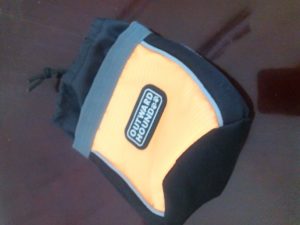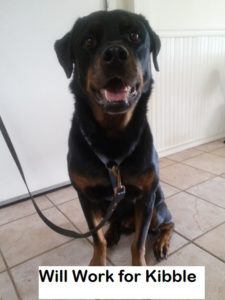Training Your Rottweiler: Getting Started
Training Gear
A good training session requires some gear so you can train easily and effectively. I like to train using scientifically approved training methods following the rewarding philosophy of positive reinforcement training. You will therefore not see choke chains, prong collars or electric collars in my training classes. Items I would recommend for training your Rottweiler are the following:
 1. Tasty Treats
1. Tasty Treats
There are treats, and there are tasty treats. You may need to experiment a bit and figure out what treat works best for your Rottweiler. Generally, you want high-value treats worthy of motivating your dog, but you do not want your dog to be too aroused by the treats that his brain goes into a stall.
Kibble for most dogs is not enough motivating, especially if you must work under distractions, but can work well when you are training indoors. For outdoors sessions, try slivers of hot dogs, freeze dried liver crumbles, chunks of roasted bone-less and skin-less chicken, or some types of store-bought treats that may motivate the most lazy dogs.
In order to work well, you want treats that are small (bite-size) and easy to eat. A crunchy cookie can be messy, take too long to be consumed and can be hard to divide in small portions. When using treats to train, consider accordingly adjusting your Rottweiler’s meal so he/she does not ingest too many calories. Many trainers will suggest bringing your Rottweiler to class on an empty stomach if he or she is low on motivation and gets easily distracted.
2. Treat Pouch
Most training centers will not allow you to bring along a plastic or a paper bag full of treats. Why? Because dogs get conditioned to the noise produced by such containers with the end result of getting distracted when you need them to concentrate. Your dog may be working on a stay and he may break his stay early if you accidentally touch the bag or if you touch the bag to get the treats before delivering your release command. So invest in a treat pouch or a fanny pack. I like the ones you can place around your waist or attach to a belt so your hands are more free when you are walking your dog on the leash.
 3. Collar/Harness/Haltis
3. Collar/Harness/Haltis
Obviously, you will have to invest in a good collar or harness. Collars must be fastened properly or your dog may slip out of them. Two fingers should be able to fit between your dog’s neck and the collar. A flat buckled collar or martingale collar are common choices.
Regular harnesses are good but they can encourage pulling. A harness with a front leash attachments such as the Easy Walk by Premier, is preferable since it can work wonders if you are training your dog to walk nice on a leash.
Head halters are another choice, but some dogs may have a hard time adjusting to them initially, but they work well since they control the head, and use pressure points to which dogs seem to respond well. These work well as aids for behavior modification programs.
Most of these training tools need gradual adjustments, this means you will have to give your dog some time to get used to the feel of these accessories and pairing their use with treats is one of the fastest ways.
4. Leash
Nylon leashes are popular but they can cut your hands if you are dealing with a hyper Rottweiler that pulls. Leather leashes may be tough at first, but they soften over time and may last quite a long time. I have owned the same leather leash for over three years and it looks like it still has many more years to live!
5. Clicker
Clickers are small noise making tools that are great markers for wanted behaviors. They are a wonderful tool for opening up shy Rottweilers that need to build a tad bit their confidence. Your clicker will turn out being your best friend for teaching your Rott some cool tricks.
6. Long Line
A long line is similar to what horse trainers use for horses. It is just that, a long line that attaches to your dog’s collar giving you control over distance. A long line may go from 15 to up 30,40 feet or more. It works great for teaching recalls or for training your Rottweiler to track.
7. Muzzle
All Rottweilers should learn how to wear a muzzle. You may never know what life brings you. You may be at the vet’s office and your dog may dislike getting handled in a certain way, or you may have to walk him in an area where there are laws where dogs must be muzzled. A good way to introduce the muzzle is to feed treats through it before being worn, so that in order for the dog to have access to them, he has to put his nose through the muzzle.
8. Attention
Of course, no training session can ultimately start without having your Rottweiler’s attention. Of course, you must start your first training session in a quiet area with little or no distractions.
One important note: an important way to get your dog’s attention is to pronounce your dog’s name immediately followed by the command. So say you want to tell your Rottweiler to sit, then you would say ‘’Petra, sit’’. Make sure you make a brief pause between your dog’s name and the command. When your dog hears her name she will be putting her listening ears on and await the command.
Be careful on the sequence and be precise. If you say ‘’Sit’’ without the name or ‘’Sit, Petra’’ she may not get it the first time and this is one of the primary causes of owners repeating commands. The name will ensure your dog is receptive to the command, the mechanism is similar to pushing the ‘’push to talk’ button on a walkie-talkie. Push it prior to talking and the message will be loud and clear, push it too late and the message will not come through 🙁